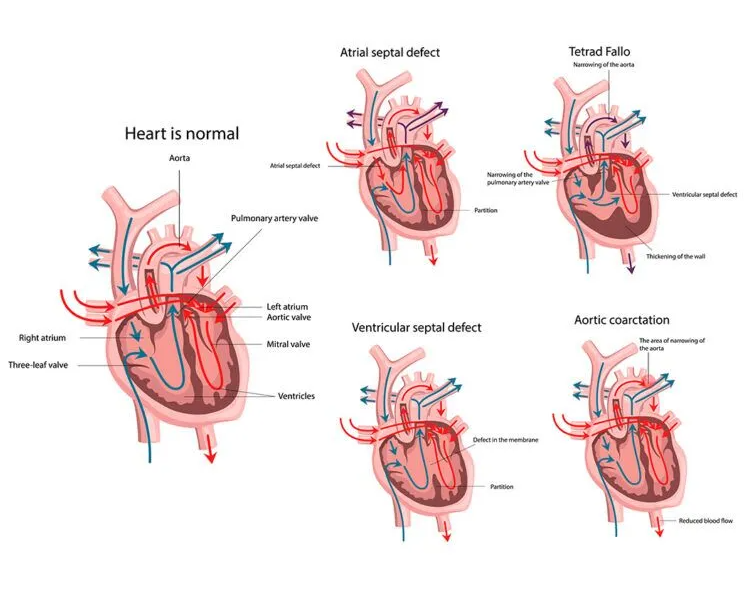Congenital Heart Diseases – What Should You Know?

Congenital heart diseases are
- Issues with the heart structures.
- Present at birth
- Problems that prevent normal blood flow
The congenital heart disease may be mild or severe.
Congenital aortic stenosis specialists classify them as:
- A hole in the heart wall.
- Problems with heart valves
- Issues with blood vessels
Some congenital heart diseases may be
- Straightforward and do not trigger symptoms
- Life-threatening, demanding immediate treatment in infancy
Typically, congenital aortic stenosis specialists in India can detect the condition early – before or after birth. However, some people remain undiagnosed until adulthood or adolescence.
Types of Congenital Heart Disease
They fall under two categories
Cyanotic – Low oxygen in the blood
Acyanotic – Oxygen level is acceptable
Cyanotic
- They reduce the oxygen the heart delivers to the body.
- Babies with this condition have low oxygen levels.
- It will demand surgery.
- Some common examples of Cyanotic disease include:
- Right heart obstructive lesions: Reduce blood flow between the lungs and the heart
- Left heart obstructive lesions: Reduce blood flow between the heart and the rest of the body
- Mixing lesions: Mixes the above two
Acyanotic
- An issue that makes the blood pump abnormally in the body.
- Some examples include
- Hole in the heart
- Problem with aorta
- Problem with pulmonary artery
How Common is Congenital Heart Disease?

It is the most common congenital condition. Over 200,000 children are born with CHD in India per year.
Symptoms
The symptoms may appear as soon as the child is born or may not appear until later in life.
Some symptoms include
- Excessive sleepiness
- Pounding heartbeat
- Weak pulse
- Poor blood circulation
- Bluish nails or lips
- Blue skin
- Troubled breathing
- Rapid breathing
- Getting out of breath during exercise
- Fatigue
- Getting unusually tired during a physical activity
- Heart murmur
The symptoms vary widely, depending on:
- Number of heart issues
- Age
- Type of condition
- Severity of condition
Visit site for More Information : Normal ejection fraction by age chart
Causes
The child has CHD when their fetal heart does not develop properly in the uterus.
- Some common causes include:
- Abnormal chromosomes
- Abnormal genes from parents
- Diabetes during pregnancy
- Phenylketonuria during pregnancy
- Rubella or other viral infection during pregnancy
- Exposure to the following during pregnancy
- Tobacco smoke
- Second-hand smoking
- Alcohol
7. Taking certain meds during pregnancy
These include drugs for
- Acne
- High BP
- High cholesterol
Complications
Congenital aortic stenosis specialists associate the following complications with CHD:
- Kidney diseases
- Heart failure
- Arrhythmias
- Liver disease
- Endocarditis
- Pulmonary hypertension
- Blood clots
- ADHD
- Speech issues
Diagnosis
Before Birth
- Doctors may find anything unusual during prenatal ultrasound.
- They may suggest further testing.
For instance, a fetal echocardiogram that creates pictures of the fetal heart.
After Birth
- Doctors can diagnose cyanotic CHD with pulse oximetry
- It is a simple, painless test.
- Pulse oximetry employs sensors on the baby’s toes or fingers.
- It helps gauge if the oxygen levels are too low.
Other Diagnosis Tests
In some cases, the diagnosis may only happen later.
Herein, doctors may recommend the following tests:
- Physical examinations
- Chest X-ray to check structural abnormalities
- Electrocardiogram to measure the heart’s electrical activity.
- Echocardiogram to create heart’s chamber and valve images
- Hear catheterisation to check how well the heart pumps or circulates blood
- Magnetic resonance imaging to create detailed heart pictures.
Treatment
The treatment involves
- A catheter procedure wherein a plug is inserted into the defect.
- Medications to help the heart work better.
- Non-surgical procedure to fix an issue with a closing device.
- Medications to manage blood pressure.
- Surgery to repair an issue – redirect blood flow, open blood flow.
- Heart transplant
- Oxygen therapy for increasing oxygen level.
- Prostaglandin E1 to help with circulation
Bottom Line
Some CHD cases do not need any treatment, while others are life-threatening and demand immediate treatment after birth. If you or someone you know has CHD, contact Dr. Raghu, a reputed cardiologist from Hyderabad with many decades of experience treating congenital disabilities.
Source Link : hopkinsmedicine.org

